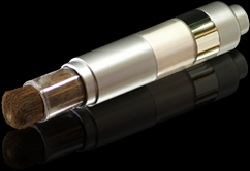|
|
| Overview Procedure Pictures Improvements References | |
ImprovementsOverall, the laser scanning system is designed well given the typical uses it is needed for but there is still room for improvement. One of the largest problems with laser scanning is capturing fine details accurately. The typical solution is to cover the object in a powder that reduces the reflectivity which reduces the likelihood of noise or missing data. This solution to the problem is effective to a point but I think by altering the lighting in addition to the powdered finish the resulting scan data would be much more cohesive. Another improvement that should be addressed is varying densities of data points. As mentioned earlier, only surfaces with normals facing the laser receiver seem to be densely populated with data points while surface textures with normals facing away from the receiver are less dense with data points or non existent. By adjusting the light source between each scan it would also be easier to piece-together each individual scan because the lighting could become the reference point as apposed to certain aspects of the object. In the setup I used, it is required to place red dots all over the object to use as reference points when splicing sets of scans together. This is troublesome in many applications because the red ink is permanent and ruins the object being scanned. The lighting adjustment mentioned earlier could be a viable method to aid in the overlapping of scans instead of marking them with red dots. Other improvements to gain better quality scans are available through adjustments in scan time and the number of scans per rotation but there is a drawback of collecting an overabundance of data and taking significantly more time which may not be necessary for all applications of the laser scanner. |
 |
| Design by Svetainių kūrimas | |